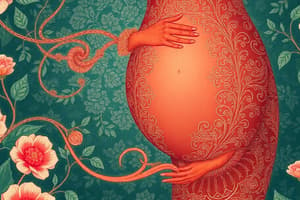Podcast
Questions and Answers
La grossesse se compose de trois ______.
La grossesse se compose de trois ______.
trimestres
La ______ se produit lorsqu'une cellule spermatique fusionne avec une cellule ovulaire.
La ______ se produit lorsqu'une cellule spermatique fusionne avec une cellule ovulaire.
fécondation
Le ______ commence à se diviser rapidement après la fécondation.
Le ______ commence à se diviser rapidement après la fécondation.
zygote
Les techniques de procréation médicalement assistée (PMA) comprennent la ______, le prélèvement d'ovocytes, la fécondation, la culture embryonnaire et le transfert d'embryons.
Les techniques de procréation médicalement assistée (PMA) comprennent la ______, le prélèvement d'ovocytes, la fécondation, la culture embryonnaire et le transfert d'embryons.
L'______ consiste à placer le sperme directement dans l'utérus pendant l'ovulation.
L'______ consiste à placer le sperme directement dans l'utérus pendant l'ovulation.
Le ______ devient finalement une partie du gros intestin chez les femmes.
Le ______ devient finalement une partie du gros intestin chez les femmes.
Le système reproducteur féminin se compose de deux ______, de trompes de Fallope et d'un utérus.
Le système reproducteur féminin se compose de deux ______, de trompes de Fallope et d'un utérus.
La différence principale entre les hommes et les femmes réside dans la présence du ______ chez les femmes.
La différence principale entre les hommes et les femmes réside dans la présence du ______ chez les femmes.
Le ______ se produit dans les 5 jours suivant la fécondation.
Le ______ se produit dans les 5 jours suivant la fécondation.
La ______ consiste à fertiliser un embryon en laboratoire et à le transférer dans l'utérus.
La ______ consiste à fertiliser un embryon en laboratoire et à le transférer dans l'utérus.
Flashcards
Trimesters
Trimesters
The three stages of pregnancy.
Fertilization
Fertilization
When a sperm cell merges with an ovum cell.
Zygote
Zygote
The rapidly dividing cell after fertilization.
Controlled Ovarian Stimulation
Controlled Ovarian Stimulation
Signup and view all the flashcards
Intrauterine Insemination
Intrauterine Insemination
Signup and view all the flashcards
Yolk Sac
Yolk Sac
Signup and view all the flashcards
Ovaries
Ovaries
Signup and view all the flashcards
Implantation
Implantation
Signup and view all the flashcards
In Vitro Fertilization
In Vitro Fertilization
Signup and view all the flashcards
Sack Vitellin
Sack Vitellin
Signup and view all the flashcards
Study Notes
Human Reproduction
Pregnancy Stages
Pregnancy consists of three trimesters, each lasting approximately 13 weeks. The first trimester begins with implantation and continues until week 12, while the second trimester extends from week 13 to week 26. The final 12 weeks constitute the third trimester, ending at 40 weeks post-conception, which represents the estimated due date.
Fertilization Process
Fertilization occurs when a sperm cell fuses with an egg cell, creating a zygote containing 46 chromosomes. The zygote begins to divide rapidly, eventually becoming a blastocyst that implants into the uterine wall within 5 days of fertilization.
Reproductive Technologies
Assisted reproductive technologies (ART) involve various stages, including controlled ovarian stimulation, oocyte retrieval, fertilization, embryo culture, and embryo transfer. Examples of ART techniques include intrauterine insemination (IUI), in vitro fertilization (IVF), and surrogacy. While IUI involves placing sperm directly into the uterus during ovulation, IVF entails fertilizing an embryo in a lab and transferring it back into the uterus.
Female Reproductive System
Women's reproductive systems consist of two ovaries, fallopian tubes, and a uterus. The primary difference between males and females lies in the presence of the yolk sac in females, which eventually becomes part of the large intestine.
Male Reproductive System
Men have two testes, epididymides, vas deferens, prostate gland, and seminal vesicles. Sperm are produced in the testes and stored in the epididymides. Upon ejaculation, sperm mix with fluids from the prostate and seminal vesicles to create semen.
Studying That Suits You
Use AI to generate personalized quizzes and flashcards to suit your learning preferences.




